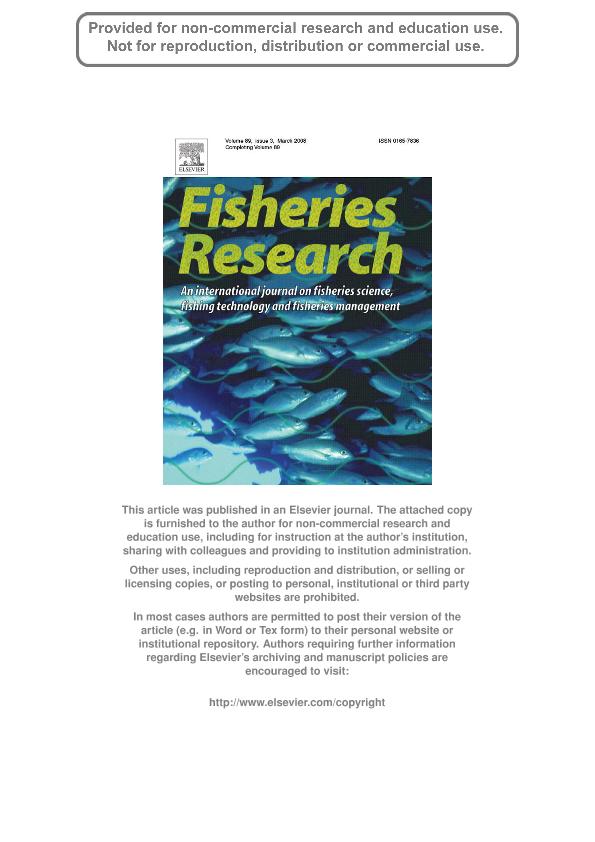Mostrar el registro sencillo del ítem
dc.contributor.author
Lomovasky, Betina Judith

dc.contributor.author
Lasta, Mario
dc.contributor.author
Valiñas, Macarena Soledad

dc.contributor.author
Bruschetti, Carlos Martin

dc.contributor.author
Ribeiro, Pablo Damián

dc.contributor.author
Campodónico, Silvana
dc.contributor.author
Iribarne, Oscar Osvaldo

dc.date.available
2020-03-26T19:50:49Z
dc.date.issued
2008-03
dc.identifier.citation
Lomovasky, Betina Judith; Lasta, Mario; Valiñas, Macarena Soledad; Bruschetti, Carlos Martin; Ribeiro, Pablo Damián; et al.; Differences in shell morphology and internal growth pattern of the Patagonian scallop Zygochlamys patagonica in the four main beds across their SW Atlantic distribution range; Elsevier Science; Fisheries Research; 89; 3; 3-2008; 266-275
dc.identifier.issn
0165-7836
dc.identifier.uri
http://hdl.handle.net/11336/100996
dc.description.abstract
Shell morphometry, internal shell growth patterns and growth rates of the Patagonian scallop Zygochlamys patagonica from four different beds across their SW Atlantic distribution range were compared. The northern beds (Uruguay, 36°17′S and Reclutas, 39°25′) showed lower shell height, length and shell mass than the southern populations (Tango B bed: 42°30′ and Beagle bed: 55°10′S). Mean height, length, and width increased following a N-S latitudinal gradient. Acetate peels revealed the presence of internal growth bands with alternating broad opaque and narrow translucent growth bands. In the Reclutas bed, the "cluster of translucent bands" representing external rings was formed mainly during winter at the same time of the higher gonadal condition index, and a regional decrease in food availability. The growth pattern observed for the first two or three growth bands was less pronounced than other growths bands, with sizes of these individuals corresponding to first maturity of the species. Thus, differences can be due to differential allocation of energy investment to shell production between juvenile and adult organisms. The internal growth patterns and maximum age differed between beds, with an increase in the maximum age from the N to the S (Uruguay bed: 13 years old, Reclutas bed: 14 years old, Tango B bed: 20 years old, Beagle bed: 21 years old). Our study provides evidence of variation of growth in Z. patagonica in the four main beds across their SW Atlantic distribution range, where a significant increase in H∞ from N to S coincides with different internal growth pattern, maximum age and a trend toward higher von Bertalanffy k parameter in the northern beds.
dc.format
application/pdf
dc.language.iso
eng
dc.publisher
Elsevier Science

dc.rights
info:eu-repo/semantics/openAccess
dc.rights.uri
https://creativecommons.org/licenses/by-nc-sa/2.5/ar/
dc.subject
ACETATE PEELS
dc.subject
AGE
dc.subject
INTERNAL SHELL GROWTH BANDS
dc.subject
SCALLOPS
dc.subject
ZYGOCHLAMYS PATAGONICA
dc.subject.classification
Biología Marina, Limnología

dc.subject.classification
Ciencias Biológicas

dc.subject.classification
CIENCIAS NATURALES Y EXACTAS

dc.title
Differences in shell morphology and internal growth pattern of the Patagonian scallop Zygochlamys patagonica in the four main beds across their SW Atlantic distribution range
dc.type
info:eu-repo/semantics/article
dc.type
info:ar-repo/semantics/artículo
dc.type
info:eu-repo/semantics/publishedVersion
dc.date.updated
2020-03-16T15:03:21Z
dc.journal.volume
89
dc.journal.number
3
dc.journal.pagination
266-275
dc.journal.pais
Países Bajos

dc.journal.ciudad
Amsterdam
dc.description.fil
Fil: Lomovasky, Betina Judith. Consejo Nacional de Investigaciones Científicas y Técnicas. Centro Científico Tecnológico Conicet - Mar del Plata. Instituto de Investigaciones Marinas y Costeras. Universidad Nacional de Mar del Plata. Facultad de Ciencias Exactas y Naturales. Instituto de Investigaciones Marinas y Costeras; Argentina
dc.description.fil
Fil: Lasta, Mario. Instituto Nacional de Investigaciones y Desarrollo Pesquero; Argentina
dc.description.fil
Fil: Valiñas, Macarena Soledad. Consejo Nacional de Investigaciones Científicas y Técnicas. Centro Científico Tecnológico Conicet - Mar del Plata; Argentina. Universidad Nacional de Mar del Plata. Facultad de Ciencias Exactas y Naturales. Departamento de Biología. Laboratorio de Ecología; Argentina
dc.description.fil
Fil: Bruschetti, Carlos Martin. Consejo Nacional de Investigaciones Científicas y Técnicas. Centro Científico Tecnológico Conicet - Mar del Plata. Instituto de Investigaciones Marinas y Costeras. Universidad Nacional de Mar del Plata. Facultad de Ciencias Exactas y Naturales. Instituto de Investigaciones Marinas y Costeras; Argentina
dc.description.fil
Fil: Ribeiro, Pablo Damián. Consejo Nacional de Investigaciones Científicas y Técnicas. Centro Científico Tecnológico Conicet - Mar del Plata. Instituto de Investigaciones Marinas y Costeras. Universidad Nacional de Mar del Plata. Facultad de Ciencias Exactas y Naturales. Instituto de Investigaciones Marinas y Costeras; Argentina
dc.description.fil
Fil: Campodónico, Silvana. Instituto Nacional de Investigaciones y Desarrollo Pesquero; Argentina
dc.description.fil
Fil: Iribarne, Oscar Osvaldo. Universidad Nacional de Mar del Plata. Facultad de Ciencias Exactas y Naturales. Departamento de Biología. Laboratorio de Ecología; Argentina. Consejo Nacional de Investigaciones Científicas y Técnicas. Centro Científico Tecnológico Conicet - Mar del Plata; Argentina
dc.journal.title
Fisheries Research

dc.relation.alternativeid
info:eu-repo/semantics/altIdentifier/url/https://www.sciencedirect.com/science/article/abs/pii/S0165783607002251
dc.relation.alternativeid
info:eu-repo/semantics/altIdentifier/doi/http://dx.doi.org/10.1016/j.fishres.2007.09.006
Archivos asociados
